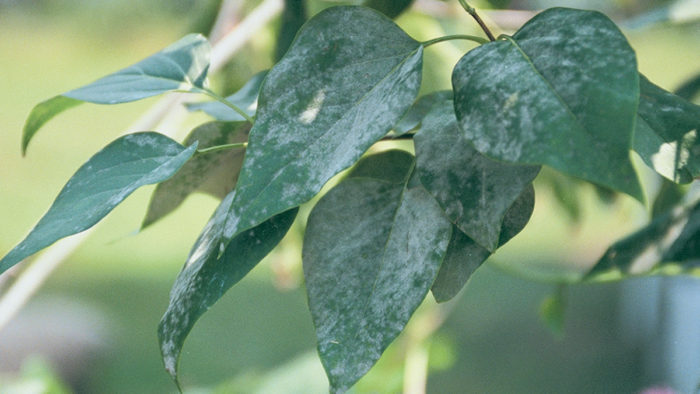Coping With Powdery Mildew
We can’t alter the weather that favors this unsightly white fungus, but we can prevent or slow its spread

Powdery mildew is one of the most common and easily recognized plant diseases. That telltale white coating on the leaves of bee balm (Monarda didyma), lilac (Syringa spp.), roses, and other susceptible plants is caused by a fungus whose spores overwinter in garden debris and are spread by the wind.
The warm days and high humidity of late spring and early summer provide perfect germinating conditions for the spores, which increase by mycelial (branchlike) growth over the surface of infected leaves. The fungus then feeds by sending small suckers known as haustoria into the host plant’s sap.
Fortunately, this disease usually only damages a plant’s appearance, not its overall health. While you cannot alter the weather that favors powdery mildew, you can prevent or slow its spread by taking the following steps:
- Site susceptible plants in early morning sun so the evening’s dew will dry quickly from their leaves.
- Provide adequate water and appropriate sun and soil conditions to minimize stress, which can decrease plants’ resistance to disease.
- Promote air circulation by giving plants plenty of space. With herbaceous perennials like phlox or bee balm, cutting out a quarter of the stems at ground level in spring will help with air movement (and increase flower size).
- Water the roots of susceptible plants—not the foliage.
- Choose mildew-resistant cultivars of susceptible plants, such as Monarda didyma ‘Bessie Bryant’ or ‘Vintage Wine’.
- If you choose to spray, use a solution of one tablespoon of baking soda and 2½ teaspoons of summer oil to one gallon of water. (Summer oil is a highly refined, low-viscosity, petroleum-based product that lightly coats leaf surfaces, preventing mycelia from penetrating into plant tissue.) Apply weekly or following a rain as a preventive measure. Sulfur sprays and powders are also sometimes used for prevention and control of powdery mildew. Always refer to label instructions when working with herbicides, pesticides, and fungicides.
Fine Gardening Recommended Products

SHOWA Atlas 370B Nitrile Palm Coating Gloves, Black, Medium (Pack of 12 Pairs)
Fine Gardening receives a commission for items purchased through links on this site, including Amazon Associates and other affiliate advertising programs.

3 Pack 4.1Inch Bonsai Pruning Scissors
Fine Gardening receives a commission for items purchased through links on this site, including Amazon Associates and other affiliate advertising programs.






Comments
Where does one buy summer oil??
Log in or create an account to post a comment.
Sign up Log in